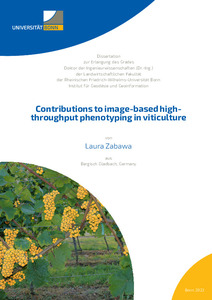Zabawa, Laura: Contributions to image-based high-throughput phenotyping in viticulture. - Bonn, 2023. - Dissertation, Rheinische Friedrich-Wilhelms-Universität Bonn.
Online-Ausgabe in bonndoc: https://nbn-resolving.org/urn:nbn:de:hbz:5-72561
Online-Ausgabe in bonndoc: https://nbn-resolving.org/urn:nbn:de:hbz:5-72561
@phdthesis{handle:20.500.11811/11078,
urn: https://nbn-resolving.org/urn:nbn:de:hbz:5-72561,
doi: https://doi.org/10.48565/bonndoc-138,
author = {{Laura Zabawa}},
title = {Contributions to image-based high-throughput phenotyping in viticulture},
school = {Rheinische Friedrich-Wilhelms-Universität Bonn},
year = 2023,
month = sep,
volume = Nr. 920,
note = {Grapevine is a crop with significant economic importance. Unlike many other crops, grapevine is a quality crop with the focus on yield optimization instead of maximization. Regular monitoring of plant diseases and pests is crucial, as they have the potential to cause significant losses by the end of the season. Therefore phenotyping plays an important role not only for breeding purposes, but also for the monitoring of the plant performance during the growth season. To ensure an optimal end product, management decisions, such as leaf removal, berry reduction, or spraying, should be implemented based on carefully extracted information. These measures are crucial to mitigate the risk of losses and maximize the overall profitability of grapevine cultivation.
Due to the perennial nature of grapevine and the often challenging terrain situation, phenotyping procedures are still performed manually, which is laborintensive, expensive and subjective. To address these challenges, there has been a growing interest in developing non-invasive, sensor-based methods. These offer fast, affordable and reliable solutions that are objective and non-invasive.
This thesis addresses three challenges in the field of image-based high-throughput phenotyping in viticulture. Firstly, we propose a novel instance segmentation method for the detection and counting of grapevine berries in images captured in the field. We evaluate our approach across two different training systems and varieties, and compare it with two state-of-the-art methods. Secondly, we investigate the potential and limitations of using the counted number of visible berries for yield estimation. We identify the variability of the leaf occlusion as the primary limiting factor. Finally, we present two different approaches for grapevine berry anomaly detection. The first is a supervised classification method that produces heatmaps with a sliding window approach. The second is a semi-supervised approach that utilizes a Variational Autoencoder (VAE) to learn the representation of a healthy phenotype and identifies anomalies as deviations from this healthy phenotype.
Overall, this thesis makes contributions to the field of image-based high-throughput phenotyping in viticulture, by proposing novel solutions for grapevine berry detection and counting, yield estimation, and anomaly detection. The approaches we present are evaluated thoroughly and compared to state-of-the-art methods, demonstrating their effectiveness in addressing these important challenges.},
url = {https://hdl.handle.net/20.500.11811/11078}
}
urn: https://nbn-resolving.org/urn:nbn:de:hbz:5-72561,
doi: https://doi.org/10.48565/bonndoc-138,
author = {{Laura Zabawa}},
title = {Contributions to image-based high-throughput phenotyping in viticulture},
school = {Rheinische Friedrich-Wilhelms-Universität Bonn},
year = 2023,
month = sep,
volume = Nr. 920,
note = {Grapevine is a crop with significant economic importance. Unlike many other crops, grapevine is a quality crop with the focus on yield optimization instead of maximization. Regular monitoring of plant diseases and pests is crucial, as they have the potential to cause significant losses by the end of the season. Therefore phenotyping plays an important role not only for breeding purposes, but also for the monitoring of the plant performance during the growth season. To ensure an optimal end product, management decisions, such as leaf removal, berry reduction, or spraying, should be implemented based on carefully extracted information. These measures are crucial to mitigate the risk of losses and maximize the overall profitability of grapevine cultivation.
Due to the perennial nature of grapevine and the often challenging terrain situation, phenotyping procedures are still performed manually, which is laborintensive, expensive and subjective. To address these challenges, there has been a growing interest in developing non-invasive, sensor-based methods. These offer fast, affordable and reliable solutions that are objective and non-invasive.
This thesis addresses three challenges in the field of image-based high-throughput phenotyping in viticulture. Firstly, we propose a novel instance segmentation method for the detection and counting of grapevine berries in images captured in the field. We evaluate our approach across two different training systems and varieties, and compare it with two state-of-the-art methods. Secondly, we investigate the potential and limitations of using the counted number of visible berries for yield estimation. We identify the variability of the leaf occlusion as the primary limiting factor. Finally, we present two different approaches for grapevine berry anomaly detection. The first is a supervised classification method that produces heatmaps with a sliding window approach. The second is a semi-supervised approach that utilizes a Variational Autoencoder (VAE) to learn the representation of a healthy phenotype and identifies anomalies as deviations from this healthy phenotype.
Overall, this thesis makes contributions to the field of image-based high-throughput phenotyping in viticulture, by proposing novel solutions for grapevine berry detection and counting, yield estimation, and anomaly detection. The approaches we present are evaluated thoroughly and compared to state-of-the-art methods, demonstrating their effectiveness in addressing these important challenges.},
url = {https://hdl.handle.net/20.500.11811/11078}
}






